What is a CMS?
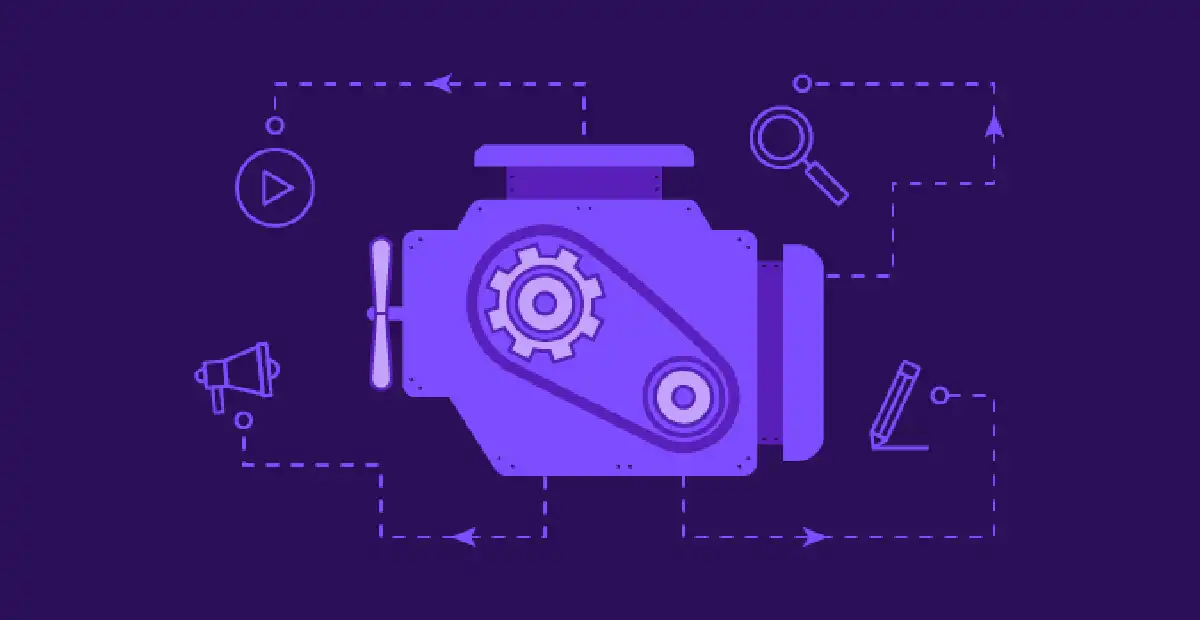
Content Marketing Institute’s 2019 Content Management and Strategy Survey — which takes a look at how enterprise marketers implement technology across their content programs — found that the majority of marketers still aren’t equipped to use technology to further their efforts.
If you’re not shocked by these results, then our guess is that you are part of the 84% who either don’t have the content management systems they need or who aren’t able to take full advantage of the tech they do have.
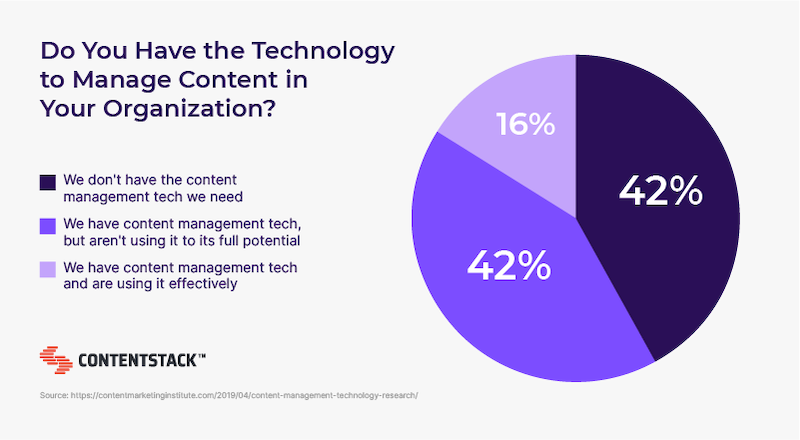
If that’s the case for your business, this article is for you!
This guide teaches you everything you need to know about a fundamental piece of marketing and content management technology: The content management system.
Stick with us to learn the ins and outs of content management system software, including:
- What a content management system is
- How to make a content management system work in your business
- The main types of content management systems from which you can choose
- Tips on picking the best content management system for your team
What is a content management system?
A content management system (CMS) is a software application that marketing teams use to create, publish, and otherwise manage content for various websites, applications, and other digital experiences.
Why do marketing teams need content management systems?
The CMS is the central hub where all of a business’s content lives and is the engine that drives all content marketing efforts — making it instrumental not only to marketing’s success but to the success of the entire organization.
That’s why instead of thinking of a CMS as a “nice-to-have” for marketing teams, today’s marketing technology decision-makers must realize that CMS is a “must-have” for the business as a whole.
How can my marketing team use a CMS?
From a marketing user’s perspective, a content management system is an interface that enables non-technical users to interact with a website’s codebase to manage content and complete other marketing actions.
Marketers most often interact with the CMS in the administration panel or “dashboard,” which is why choosing a CMS is often based on how easy this panel is to use. From this panel, a marketing professional should have access to crucial content management features such as content creation, preview, and publishing; content reviewing and approval flows; content versioning; asset management; and more.
Below is what a pretty typical admin panel from a modern, easy-to-use CMS looks like:
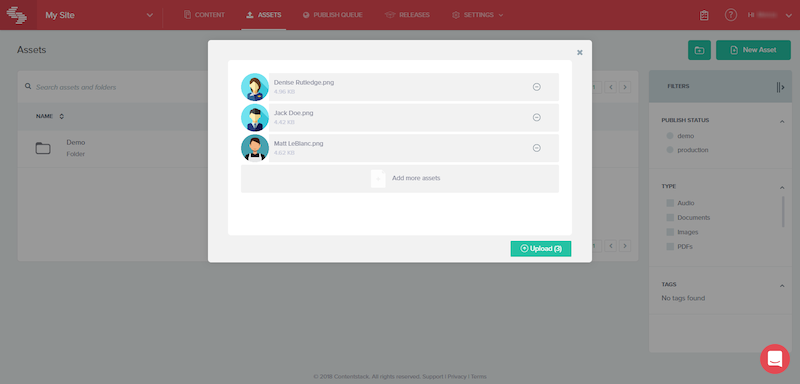
As you can see, using a modern CMS is easier for marketers than the alternative — interacting directly with your database to source the necessary images, videos, and other assets then creating and uploading an HTML content file to your web server.
The main types of content management systems
In this section, we’ll explore everything you need to know to choose the type of CMS that will fit your team and your business the best.
Monolithic content management systems
The monolithic content management system is the original, or “traditional,” CMS. A monolithic CMS ties together, or “couples,” the content database (called the backend or “body”) where content is managed and the content presentation layer (known as the frontend or “head”) where that content is formatted.
This coupling means that content is inextricably attached to its formatting, so reusing it on another platform or another audience usually requires a total rewrite and redesign. This infrastructure was built when marketers only needed to publish static content to singular, static websites. That’s why this type of CMS can struggle to meet consumer demand for an omnichannel experience and business users who demand ease of use without add-ons and workarounds.
The key benefit of using a monolithic CMS
The key benefit of a monolithic CMS is the same as why they’re still available and in use today — they make content management easy for marketers who only need to create and manage static content on a single website. This means they’re still handy for bloggers and businesses that only need to maintain small, simple websites.
The downsides of working with monolithic CMSes
To keep up with omnichannel experiences and usability demands, most organizations stuck with monolithic CMSes have had to come up with custom code, plug-ins, and a lot of workarounds.
These short-term solutions create dependencies that introduce security concerns and are always at risk of causing cascading errors any time they need to be changed or updated — which only serves to further handicap businesses who want to adopt new technology.
This “handcuffing” nature of monolithic CMSes is their biggest downfall for businesses and marketing departments that want to keep up with modern trends.

Headless content management systems
The headless CMS was designed as a direct answer to the shortcomings of a monolithic CMS. A headless CMS decouples the content database and presentation layer — thus the name “headless.”
This architecture makes it so that managing content and designing it for publishing can happen separately yet simultaneously. With a headless CMS, the marketing team can create and store content collateral using independent modules. Simultaneously, designers and developers can create the best display for that content, whether delivering it to a website, a smart billboard, or any other internet-enabled device.
The content database, presentation layer, and any additional marketing applications all work together with an application programming interface (API) technology that enables technology to communicate with each other.
Advantages of headless CMS
Headless CMS software is created to keep up with ever-changing marketing trends; there are several advantages to adopting headless CMS. First, a headless CMS is the best solution for publishing dynamic content to various channels, devices and audiences. That’s because its modular architecture enables content to be quickly reorganized and reoptimized — instead of re-created — so it’s ready for the right consumer, at the right time, in the right context.
This same API-powered system also makes it easy to integrate with best-of-breed business applications such as SEO tools, translation services, analytics, multimedia, and more. These applications empower marketers to take their content optimization to the next level. And since all these tools connect via an API, it’s easy to change them anytime and any way you like without worrying about delicate dependencies.
Additionally, decoupled content and technology means marketers and developers can work within the same system — and even on the same content or campaign — at the same time. The ability to work simultaneously can have a significant positive impact on morale and time to market.
The main disadvantages of some headless CMSs
Of course, before you can "go headless," there are a few disadvantages of which to be aware. A headless CMS requires a developer to get the system up and running. If you only need a simple, small website, for example, to post blogs, a headless site is likely overkill. Additionally, a headless CMS's decoupling means many of these platforms don't have an easy-to-use, consumer-friendly interface, such as a WYSIWYG editor. A headless CMS also might not include a way to stage and preview pages before going live.
However, there are many headless CMSs on the market, so marketing technology decision-makers should look out for enterprise-ready headless CMS platforms that come equipped with features focused on marketing users.
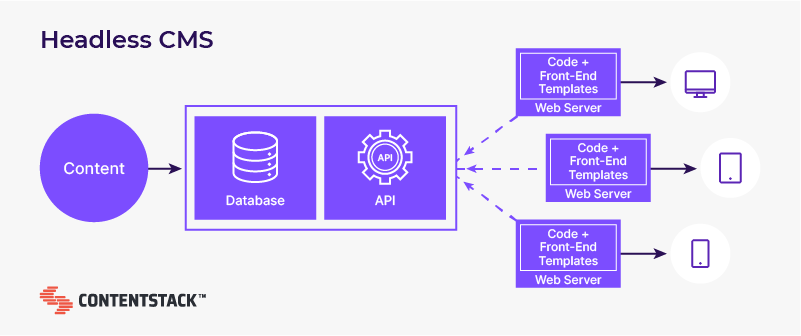
Hybrid content management systems
And then there is a mix of the two: Hybrid CMS. A hybrid CMS is a (sort of) headless CMS that still has a front end. Even though it employs a decoupled back end that uses a content-as-a-service (CaaS) API to deliver content, a hybrid CMS includes a presentation layer similar to that of a traditional CMS. This provides developers the freedom to deliver content across channels using a CaaS API. At the same time, marketers still get a similar interface they’re used to working with using a traditional CMS in the past.
The upsides of hybrid CMS
The benefits of hybrid CMS are similar to those that make headless CMS so useful for marketers. First is the enhanced authoring experience in the administration panel that enables marketers to intuitively manage content and view what it’s going to look like before it goes live. There are also hybrid content modules that, similar to headless CMS modules, enable content to be labeled, searched, and quickly reoptimized for publishing across channels.
The limitation of hybrid CMS
While a hybrid CMS has upsides of both headless and monolithic solutions, there is one thing to be aware of when looking into a hybrid CMS. Some hybrid solutions are not built as API-first systems. Because of the headless CMS’s popularity, some companies add APIs to their monolithic CMS and call the system a hybrid CMS. Because a hybrid CMS still has a front end similar to a monolithic CMS, it doesn’t have unlimited flexibility for taking advantage of API-powered services, integrations and omnichannel content delivery to internet-enabled devices.
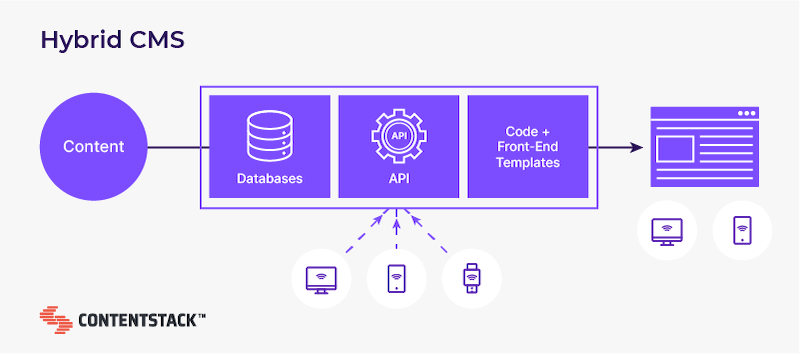
How to choose the right CMS
Unfortunately, we can’t give you a definitive answer on which of the leading types of CMS solutions is best for your organization — it depends on your business capabilities and objectives.
But what we can do is give you these questions that will help you start narrowing down your priorities and thus, which content management system is best for you:
- How important is ease of use for your marketing team? How about for your IT team? Different CMSs are more and less easy for different types of users to operate. For example, a monolithic CMS is perhaps the easiest for marketing users to work with, while a headless CMS is probably the most usable for IT folks.
- How much customization do you need — now and in the future? Some CMS solutions will be harder to customize, so be sure to consider how much work you want to do and even can do to customize your solution.
- How important are flexibility and ability to scale? Do you need to be able to change up marketing extensions often? Do you need flexible content modules that enable omnichannel distribution? If so, remember that you’re better off going with an API-first CMS.
- Which resources do you have access to (a development team, etc.)? It’s not advisable to choose a solution that you don’t have the ongoing resources to support.
For even more insight to help you choose the best CMS for your business, check out our detailed guide, aptly named “How to Choose a CMS.”
Keep learning about content management systems
If you want to learn even more about content management system software before choosing a solution for your team, check out the following free ebooks to learn just about everything there is to know about CMSes and boost your confidence when choosing one:
The ultimate guide to headless CMS: Learn all about the architectural differences between various types of CMSes. Take a comprehensive look at the pros and cons of using different types of CMSes. Check out common use cases for CMSes.
About Contentstack
The Contentstack team comprises highly skilled professionals specializing in product marketing, customer acquisition and retention, and digital marketing strategy. With extensive experience holding senior positions in notable technology companies across various sectors, they bring diverse backgrounds and deep industry knowledge to deliver impactful solutions.
Contentstack stands out in the composable DXP and Headless CMS markets with an impressive track record of 87 G2 user awards, 6 analyst recognitions, and 3 industry accolades, showcasing its robust market presence and user satisfaction.
Check out our case studies to see why industry-leading companies trust Contentstack.
Experience the power of Contentstack's award-winning platform by scheduling a demo, starting a free trial, or joining a small group demo today.
Follow Contentstack on Linkedin


.svg?format=pjpg&auto=webp)


.svg?format=pjpg&auto=webp)
.svg?format=pjpg&auto=webp)
.svg?format=pjpg&auto=webp)
.svg?format=pjpg&auto=webp)






